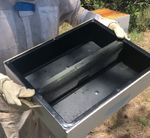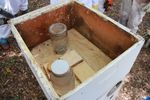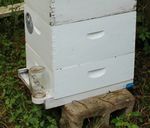GENERAL MAINTENANCE OF HONEY BEE HIVES - Extension ...
←
→
Page content transcription
If your browser does not render page correctly, please read the page content below
ENTO-096 01/21
GENERAL MAINTENANCE OF HONEY BEE HIVES
Molly Keck*
Most experienced beekeepers and apiculturists agree Honey bees should be fed a sugar syrup ratio of 1:1
there are two reasons honey bee colonies fail: (1) failure (sugar-to-water) by weight during spring, summer, and
to monitor and treat for Varroa mites; and (2) failure to fall. During winter, the ratio should be 2:1 (sugar-to-
feed starving bees. water) by weight. The water will need to be heated to
dissolve the sugar. Avoid boiling and be sure the syrup is
completely cooled before introducing it to the bees.
VARROA MITE MANAGEMENT
There are many options for feeding. External feeders
It is imperative to monitor for Varroa mites regularly.
(Fig. 2) and entrance feeders (Fig. 3) are placed outside
When mite numbers become too high, colonies die.
There are many resources available with information on
how to monitor Varroa mites and interpret results. The
Honey Bee Health Coalition is an excellent resource that
provides videos, guides, and other tools to monitor and
manage Varroa mites. More information can be found
on their website at: https://Honeybeehealthcoalition.org/
Varroa/.
Figure 2. External feeder
Figure 1. Varroa mite (USDA)
FEEDING
Bees are generally fed in early spring before nectar
sources are abundant, during times of drought or nectar
dearth, and in preparation for winter if they do not have
enough stored honey. However, depending on the area
of Texas, some colonies may need to be fed nearly all
year.
Figure 3. Entrance feeder—often considered
a type of external feeder
*Integrated Pest Management Program Specialist–Bexar County
► 1the hive and may promote robbing (i.e., when stronger
colonies steal food from weaker colonies) or attract
pests. There is also no way of knowing how much food
the beekeepers’ bees have consumed.
Internal feeders come in a variety of different forms as
well. Some popular versions are frame feeders and top
feeders.
Frame feeders (Fig. 4) take the place of a frame inside
the colony and contain up to 1 gallon of sugar water.
Top feeders (Fig. 5) sit on top of the last super, and bees
feed through a mesh screen between two wells, each Figure 6. Homemade internal top feeder. Empty box
containing a gallon of sugar water. Many variations of with plywood bottom. Holes the size of jar tops drilled
top feeders can be homemade (Fig. 6). Construction out of the bottom so jars can be placed upside down. Jar
options include drilling holes in a plywood sheet and tops have numerous small holes so sugar water can be
extracted by honey bees’ lapping mouthparts.
placing jars upside down for bees to feed from. Some
beekeepers use an empty box and place chicken
waterers with marbles in the well to prevent drowning.
Table 1. Pros and cons of external and internal feeders
External Internal Frame Internal Top
Feeders Feeder Feeder
Easy to fill, do Will likely have to May have to suit up
not have to suit suit up to refill to refill
up
Do not know Know exactly Know exactly
how much how much food how much food
food the hives is consumed in a is consumed in a
consume certain timeframe certain timeframe
Bees will not Closer to the May be far from the
forage and brood, and easier brood and queen,
feed when the for bees to find and bees may not
weather is too during cold months find food quickly in
cold cold weather
BEEKEEPING SEASONS
Figure 4. Internal frame feeder
In addition to mite checks and feeding, a beekeeper will
work with bees nearly all year. Here is a general idea of
what to expect in beekeeping, by season:
Early Spring
This is a time of growth for the colony, and they will
often need more food than they can forage. Thus, it
is a critical time to feed bees. Although wildflowers
may be blooming, there are probably more larvae in
need of feeding than there is food available. Perform a
mite check at this time and carry out the appropriate
treatment, if needed. Healthy colonies may be split to
grow the bee yard. Check the bees only every other
week, as checking too often may induce stress on the
hive.
Mid Spring–Early Summer
Growth of the colony continues during this time and the
bees are usually bringing in enough food to support the
Figure 5. Internal top feeder
colony. If the hive has been treated for mites, remove
► 2pesticide strips according to the label directions. Bees
may become crowded at this time, so add new boxes
RE-QUEENING
as needed. Honey supers and queen excluders are It is a good practice to re-queen honey bee colonies
generally placed on hives in mid-spring. Checking hives every 1 to 2 years. Many beekeepers will requeen in the
every other week will prevent colonies from swarming. fall to stop the production of eggs for a short period of
time and disrupt the Varroa mite life-cycle, reducing the
Colonies that have failed to increase in population population of mites going into winter months.
should be inspected to determine the reasons for their
slow growth (i.e., failing queen, lack of resources, pest, Some beekeepers prefer to re-queen quickly, and others
or disease issue). During this time, beekeepers should prefer a slow release method. The method described
be able to split colonies, as they are still on a population here is a slow release, which can be modified based on
rise and have yet to hit their peak. time constraints and the situation.
Be sure to have a queen available and on hand, first.
Summer Remove the old queen from the colony and kill her by
At this time, honey may be capped and can be whichever means preferred. Many beekeepers prefer
harvested. decapitation by pinching off the head because it is quick
and reduces suffering. After removing the old queen,
After harvesting, monitor for mites and perform leave the colony queen-less for 1 to 3 days. At this time,
appropriate treatment. During years of drought, feeding the colony should be accepting of a new queen.
may be necessary. Provide water sources if there is no
natural source and check every other week to ensure Carefully inspect the frames to ensure that the workers
that the bees do not need more space. have not started to rear a new queen. Look for a
queen cell with a larva and/or royal jelly. If one is found,
Fall destroy it immediately.
As temperatures cool and rainfall is more frequent, Depending on what type of cage the new queen arrives
beekeepers may experience a second nectar flow. Be in, the following instructions may vary. Remove the cork
cautious about taking honey from bees at this time plug or stopper on the candy end of the cage by pushing
because they need enough food to get through winter. a small nail or twig into the candy to start a hole. Be
This may be the last chance to re-queen for the year and very careful not to poke the queen. Then, place the
it is recommended as a management practice to disrupt queen cage in between two brood frames (use the wax
the Varroa mite lifecycle. Monitor for mites during this to hold the cage in place). Beekeepers’ thoughts vary on
time to reduce their population going into winter. the orientation of the cage, but remember: During hot
months, placing the cage vertically, candy side up may
Winter cause the candy to melt and kill the queen. Vertically,
candy side down may allow dead attendant workers to
Hives should not be opened on days cooler than 60°F,
clog the exit so the queen cannot leave. To avoid both
and brood frames should not be pulled or left out of
of these situations, place the cage horizontally with
the hive whatsoever. Queens may stop laying eggs,
the screen facing down. Then smear a small amount
and foraging will slow significantly. Feed bees that do
of honey on the mesh side to both feed the queen and
not have enough food stores and check hives for food
allow the workers to become acclimated with her.
reserves on warm days. A ratio of one frame of honey
per two frames of brood is a conservative estimate for Lastly, close up the hive for 5 to 7 days. After that time,
adequate food stores. Those with less than one frame check to ensure the queen has been released. If she has
of honey per frame of brood will likely need assistance not, carefully open the cage and allow her to walk onto
during the winter. a frame.
For more information on seasonal “to-do’s,” visit Additional online resource available through
Texas Honey Bee Education Association’s website: AgriLife Learn, Beekeeping 101: https://agrilifelearn.
https://thbea.com/wp-content/uploads/2019/04/ tamu.edu/product?catalog=ENTO-025
THBEA-NewBee-Brochure-2018.pdf
Texas A&M AgriLife Extension is an equal opportunity employer and program provider. AG R I L I F E E X T E N S I O N .TA M U. E D UYou can also read

























































